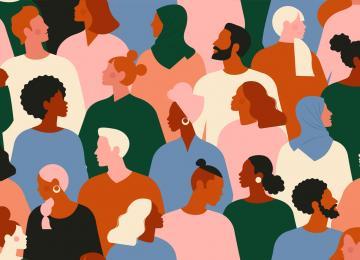
Regulators share their thoughts on the pandemic’s potential impacts on EDI in engineering.

This is the second article in a three-part series on equity, diversity, and inclusion in the engineering profession. Read part 1.
Equity, diversity, and inclusion (EDI) work is and has always been challenging because it invites us to self-reflect as individuals, and as organizations. It requires the exploration and acknowledgement of inequities and overcoming the defensiveness that comes from conversations on power and privilege.
While such conversations and reflection can be challenging, they are also important if change is to succeed. In light of the recent Black Lives Matter protests that have taken place around the world and the focus these have placed on diversity and inclusion topics, Engineers Canada reached out to our colleagues at the Canadian engineering regulators who are working on improving EDI in the profession. The ongoing COVID-19 pandemic has also impacted these EDI discussions, with recent suggestions that it may usher in a ‘she-cession.’ In this second article of a three-part series, the engineering regulators share their thoughts on the potential short- and long-term impacts, both negative and positive, that the pandemic may have on EDI in engineering.
Engineers Canada: What do you think is the impact of COVID-19 on EDI in engineering?
 Mohamed El Daly, Director, Outreach and Product Services, APEGA: We do see that engineering and geoscience organizations in Alberta have been severely impacted by the economic downturn, the downturn in the price of oil, and now COVID-19—to the point that EDI initiatives, for many engineering and geoscience organizations have gone completely by the wayside as they struggle to focus on simply keeping the business functions of their organizations running.
Mohamed El Daly, Director, Outreach and Product Services, APEGA: We do see that engineering and geoscience organizations in Alberta have been severely impacted by the economic downturn, the downturn in the price of oil, and now COVID-19—to the point that EDI initiatives, for many engineering and geoscience organizations have gone completely by the wayside as they struggle to focus on simply keeping the business functions of their organizations running.
We speak a lot about the interruption having the workforce working from home has caused, and possible gendered differences—but we have not yet done any meaningful analysis of this question.
An additional concern that we have, but have not investigated in a meaningful way, is during this phase where essential workers are returning to the office, if it is gendered in terms of who returns first, and the impacts that will have on the business if women are being left out of the first wave to return.
 Lisa Stepnuk, Director, Equity and Representation, Engineers Geoscientists Manitoba: Women already take on more care work of children, elders, friends, family and community. Some women have had to take leave or put their careers on hold altogether to manage. COVID-19 may exacerbate this pre-existing phenomenon. We will see what happens long term with the re-opening of schools, access to affordable and quality childcare, and long-term care homes. There could be major setbacks in terms of the numbers of women and the effects of this on workplace culture and policies. Organisational survival of COVID-19 and economic recession can be used as an excuse to put EDI work on hold when it is as or more important than ever to accelerate the work.
Lisa Stepnuk, Director, Equity and Representation, Engineers Geoscientists Manitoba: Women already take on more care work of children, elders, friends, family and community. Some women have had to take leave or put their careers on hold altogether to manage. COVID-19 may exacerbate this pre-existing phenomenon. We will see what happens long term with the re-opening of schools, access to affordable and quality childcare, and long-term care homes. There could be major setbacks in terms of the numbers of women and the effects of this on workplace culture and policies. Organisational survival of COVID-19 and economic recession can be used as an excuse to put EDI work on hold when it is as or more important than ever to accelerate the work.
Conversely, the relatively quick turnaround workplaces and workers were forced to make to allow and accommodate working remotely will hopefully have long-term impacts on the flexible work requirements that many disability advocates, parents, and caregivers had already been advocating for.
 Laura Douglass, Diversity & Inclusion Coordinator, APEGNB: I think that we are seeing the impact of COVID-19 in a few different ways as it pertains to EDI. There has been discrimination and harassment against Asian Canadians all over the country, and engineering schools and workplaces are not immune to this. We also can look at the differences between the roles of men and women as they work from home and balance family life, often including young kids. Anecdotally we have heard that much of the additional work of having kids home during the day and homeschooling is falling on the shoulders of women, impacting their ability to participate fully in meetings, be efficient in their workday, or complete important tasks. While this is not the case for all families, it is a disappointing (although unsurprising) trend.
Laura Douglass, Diversity & Inclusion Coordinator, APEGNB: I think that we are seeing the impact of COVID-19 in a few different ways as it pertains to EDI. There has been discrimination and harassment against Asian Canadians all over the country, and engineering schools and workplaces are not immune to this. We also can look at the differences between the roles of men and women as they work from home and balance family life, often including young kids. Anecdotally we have heard that much of the additional work of having kids home during the day and homeschooling is falling on the shoulders of women, impacting their ability to participate fully in meetings, be efficient in their workday, or complete important tasks. While this is not the case for all families, it is a disappointing (although unsurprising) trend.
 Kathy Baig, President, Ordre des Ingénieurs du Québec (OIQ): The lockdown has exacerbated the challenges faced by our society. A survey on women engineers’ professional growth conducted in the summer of 2019 by Ipsos revealed that 26 per cent of our women engineers found it hard to balance work and family life, compared to 13 per cent of our male engineer respondents. It became even harder when families with school-aged children were confined to homes. Employers had to be more flexible during this period and a good number of engineers, both men and women, worked remotely. Nevertheless, they had to rearrange their schedules so that they could take care of their children while working. Many found themselves in complicated situations that forced them to make some tough decisions. As for internationally trained professionals, they may see their entry in the job market delayed due to interrupted university courses and admission examinations as well as the hiring slowdown in businesses and other organizations.
Kathy Baig, President, Ordre des Ingénieurs du Québec (OIQ): The lockdown has exacerbated the challenges faced by our society. A survey on women engineers’ professional growth conducted in the summer of 2019 by Ipsos revealed that 26 per cent of our women engineers found it hard to balance work and family life, compared to 13 per cent of our male engineer respondents. It became even harder when families with school-aged children were confined to homes. Employers had to be more flexible during this period and a good number of engineers, both men and women, worked remotely. Nevertheless, they had to rearrange their schedules so that they could take care of their children while working. Many found themselves in complicated situations that forced them to make some tough decisions. As for internationally trained professionals, they may see their entry in the job market delayed due to interrupted university courses and admission examinations as well as the hiring slowdown in businesses and other organizations.
 Marcie Cochrane, 30 by 30 Coordinator, Engineers and Geoscientists BC: At this point it is difficult to assess the impact of COVID-19 on EDI in engineering, but we have identified both some potential positive and negative impacts. On the positive side, the shift to working remotely can benefit inclusion if this is a future practice that companies adopt on even a part time basis. This change can benefit all individuals but can be especially beneficial to those who are geographically dispersed, those with mobility issues, and those who have family commitments that can be difficult to balance when in the office full time.
Marcie Cochrane, 30 by 30 Coordinator, Engineers and Geoscientists BC: At this point it is difficult to assess the impact of COVID-19 on EDI in engineering, but we have identified both some potential positive and negative impacts. On the positive side, the shift to working remotely can benefit inclusion if this is a future practice that companies adopt on even a part time basis. This change can benefit all individuals but can be especially beneficial to those who are geographically dispersed, those with mobility issues, and those who have family commitments that can be difficult to balance when in the office full time.
In contrast, the negative career impacts of working from home during the pandemic are not equitable. Specifically, consideration has been given to the impacts of working from home and the gendered impact because women typically still perform more of the unpaid household work, including family care obligations. The result is that it is more likely that women have had to adjust their work commitments, or their work performance has suffered while they also juggle responsibilities such as childcare and education support. There are impacts on other groups, such as those with physical limitations who may not be able to set up a makeshift home office that is suitable for their needs, potentially impacting their ability to perform their work during this time.
With the initial shift to working remotely and now the process of beginning to return to office, inclusion has required new perspective and consideration. If not included in return to office plans, there will be exclusion, and the impact of this will not be equitable. Those individuals who have to stay at home for reasons such as family care or health will see a bigger impact than those who return to the office, missing out on sidebar conversations, impromptu but important discussions, and missing assignments because they are “out of sight, out of mind.” These individuals are, in most cases, already under-represented in engineering, such as women and those with disabilities.
Check back in the next edition of Engineering Matters for the third article in this three-part series, in which Cochrane, Stepnuk, Douglass, Baig, and El Daly offer tips on how to overcome diversity fatigue.


